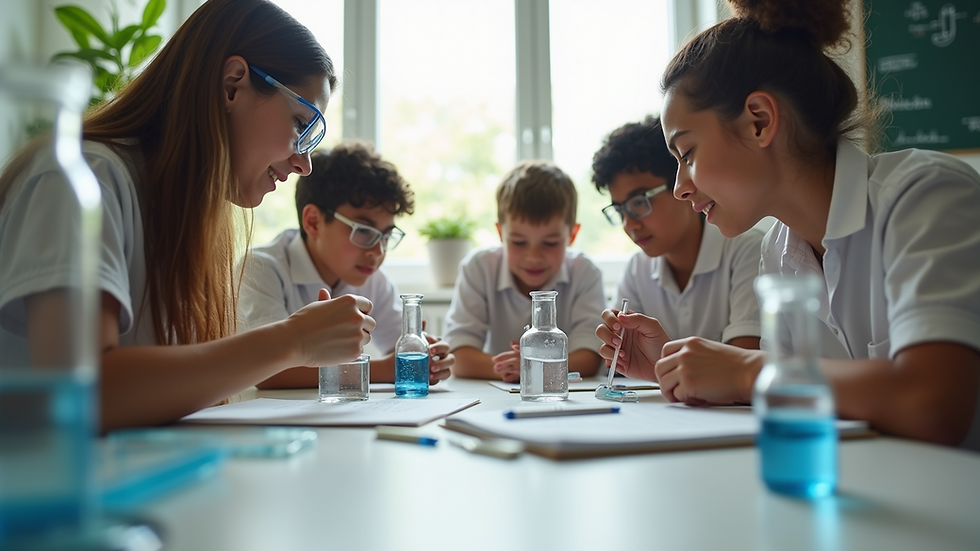Empowering Students Through Personalized Learning Strategies
- WeMind Academy of Learning
- 5 days ago
- 4 min read
Education is not one-size-fits-all. Every student brings unique strengths, challenges, and interests to the classroom. Traditional teaching methods often overlook these differences, leading to disengagement and missed opportunities for growth. Personalized learning strategies offer a way to meet students where they are, helping them build confidence and succeed on their own terms.
This post explores how personalized learning can transform education by focusing on individual needs, adapting teaching methods, and encouraging active participation. You will find practical examples and actionable ideas to support students in becoming more independent and motivated learners.
Understanding Personalized Learning
Personalized learning means tailoring education to fit each student's abilities, preferences, and pace. It contrasts with the traditional model where all students receive the same instruction regardless of their background or skills.
Key features of personalized learning include:
Student-centered goals: Students set learning targets based on their interests and strengths.
Flexible pacing: Learners progress at a speed that suits their understanding.
Varied instructional methods: Teachers use different approaches to match learning styles.
Ongoing assessment: Regular feedback guides adjustments to the learning plan.
By focusing on these elements, educators can create an environment where students feel valued and supported.
Benefits of Personalized Learning for Students
Personalized learning offers several advantages that help students thrive academically and personally:
Increased engagement: When lessons connect to students’ interests, they become more motivated.
Improved confidence: Mastering material at their own pace reduces frustration and builds self-esteem.
Better retention: Tailored instruction helps students understand concepts deeply.
Development of critical skills: Students learn to take responsibility for their learning and solve problems creatively.
For example, a student struggling with math might receive extra practice using visual aids, while another excelling in reading could explore advanced literature. This approach respects individual differences and encourages growth.
Strategies to Implement Personalized Learning
Teachers and schools can adopt various strategies to make learning more personalized. Here are some effective methods:
1. Use Diagnostic Assessments
Start by identifying each student’s current knowledge and skills. Diagnostic tests or informal quizzes help pinpoint strengths and areas needing support. This information guides lesson planning and grouping.
2. Set Individual Learning Goals
Work with students to set clear, achievable goals. These goals should reflect their interests and academic needs. For example, a student interested in science might aim to complete a project on renewable energy.
3. Incorporate Technology
Educational technology offers tools that adapt to student performance. Programs can provide customized exercises, track progress, and offer instant feedback. This allows students to practice independently and receive support when needed.
4. Differentiate Instruction
Vary teaching methods to suit different learning styles. Use visual, auditory, and kinesthetic activities to engage all students. Group work, hands-on experiments, and storytelling can make lessons more accessible.
5. Foster Student Choice
Allow students to choose topics, projects, or formats for assignments. Giving them control increases ownership and motivation. For instance, students might select between writing an essay, creating a video, or designing a poster.
6. Provide Regular Feedback
Offer timely, specific feedback that helps students understand their progress. Encourage self-assessment and reflection to build awareness of learning habits and areas for improvement.

Student engaged in a hands-on personalized learning activity, focusing on creativity and individual interests.
Examples of Personalized Learning in Action
Case Study 1: Project-Based Learning in Middle School
A middle school teacher introduced project-based learning where students chose topics related to environmental science. Each student researched a specific issue, created a presentation, and shared findings with the class. The teacher provided resources and guidance tailored to each project.
This approach allowed students to explore subjects they cared about while developing research and communication skills. The teacher noticed increased enthusiasm and deeper understanding compared to traditional lectures.
Case Study 2: Adaptive Math Software in Elementary School
An elementary school used adaptive math software that adjusted difficulty based on student responses. Students worked independently on tablets, receiving challenges suited to their level. Teachers monitored progress through dashboards and offered targeted support.
Students who struggled with certain concepts received extra practice, while advanced learners moved ahead without waiting. This personalized pacing helped reduce gaps and boosted confidence.
Overcoming Challenges in Personalized Learning
Implementing personalized learning can be challenging. Common obstacles include:
Limited resources: Not all schools have access to technology or materials.
Time constraints: Planning individualized lessons requires extra effort.
Teacher training: Educators need support to develop new skills.
Balancing group and individual needs: Managing diverse learners in one classroom can be complex.
To address these challenges, schools can:
Start small by personalizing one subject or unit.
Use free or low-cost digital tools.
Provide professional development focused on personalized instruction.
Encourage collaboration among teachers to share strategies.
Supporting Parents and Caregivers
Parents play a crucial role in personalized learning. They can:
Communicate regularly with teachers about their child’s progress.
Encourage exploration of interests outside school.
Create a supportive home environment for study.
Help set realistic goals and celebrate achievements.
Schools can involve families by hosting workshops and sharing resources that explain personalized learning benefits and practices.
The Role of Students in Personalized Learning
Students must take an active role to benefit fully. They can:
Reflect on their learning preferences and challenges.
Set personal goals and track progress.
Ask for help when needed.
Experiment with different study methods.
Teaching students these skills builds independence and prepares them for lifelong learning.
Personalized learning transforms education by recognizing each student’s unique path. It creates opportunities for deeper engagement, stronger skills, and greater confidence. By adopting practical strategies and fostering collaboration among teachers, students, and families, schools can create learning experiences that truly support every learner’s success.
Take the next step by exploring personalized learning tools or discussing with educators how to bring these strategies into your classroom or home. The future of education depends on meeting students where they are and helping them reach their full potential.


Comments